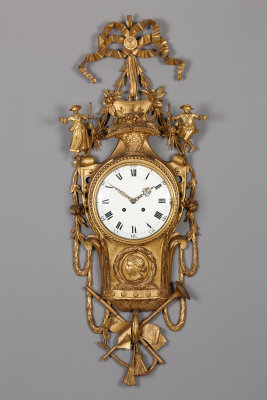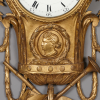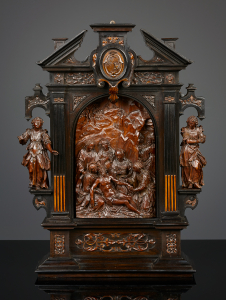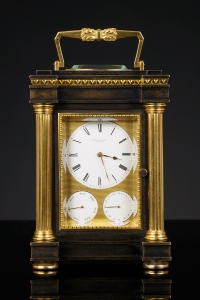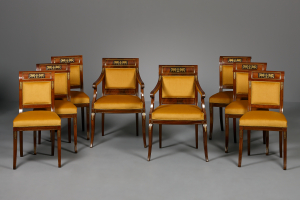Large Dutch Louis XVI wooden cartel clock
Large Dutch Louis XVI wooden cartel clock
The movement has an eight-day going train with an anchor escapement. The striking train with countwheel sounds the hours fully and the half hours with a single strike. Roman numerals mark the hours; the minutes are indicated with Arabic numerals. The movement is signed “W.H.K. van der Horst Amsterdam”. Van der Horst worked in Amsterdam around 1790 and had a workshop in Warmoesstraat.
This is an exceptionally large wooden cartel clock in classicist style. The centrally placed enamelled dial with Roman numerals for the hours and Arabic numerals for the minutes is installed in a case whose design is clearly based on French models. Cartel clocks were in fashion in France throughout the entire eighteenth century, especially fire-gilt models, and such pieces were soon exported to the Netherlands. In view of the fact that very few fire-gilt objects were produced in the Netherlands, this wooden cartel clock may be regarded as a typically Dutch interpretation of a French model.
The degree of refinement on display in the carvings and the elaborate decorative scheme, including the fruit basket, the ribbon from which the clock is suspended, and the medallion, is often found in Dutch mirrors and the carvings on wainscoting from the second half of the eighteenth century.
The fruit basket is flanked by child-like figures in shepherd’s and shepherdess’s clothing. Pastoral scenes were very popular in the seventeenth and eighteenth centuries. The idyllic landscape of classic Arcadia, which had been popularised by pastoral literature around 1600, was populated with simple characters who led simple lives, often depicted as shepherds and shepherdesses. The pureness they represent was perceived as idyllic. This land of harmony and innocence was therefore the perfect setting for young children, who were after all also seen as innocent.
The maker of this clock was likely inspired by the models of Delafosse. As the most important designer and decorator of the eighteenth century, Jean-Charles Delafosse (1734-1791) played an important role in the reform of the neoclassicist style in France. A Parisian architect, ornament designer and engraver, Delafosse was highly influential in the propagation of the goût antique. In 1774, he apprenticed under sculptor Jean-Baptiste Poullet (d. 1775), but it seems he did not complete his apprenticeship.
Instead, he focused his efforts on becoming a designer and architect. To that end, he took to calling himself “architecte et professeur pour le dessin” (architect and professor of draughtsmanship) in 1767. Delafosse was an influential figure, especially in his capacity as an innovative, radical designer. In 1768 he published the first part of his most important work, the Nouvelle Iconologie Historique (New Historical Iconology), containing 110 engravings, most of them by Delafosse himself. These included designs for furniture, decorative objects and architectural ornaments in the weighty, classicist Louis XVI style.
Depicted in:
Trade journal ANTIEK, October 1991, p. 171
- Period
- ca. 1790
- Material
- gilt basswood, enamelled dial
- Signature
- W.H.K. van der Horst Amsterdam
- Dimensions
- 116 cm
Global shipping available
